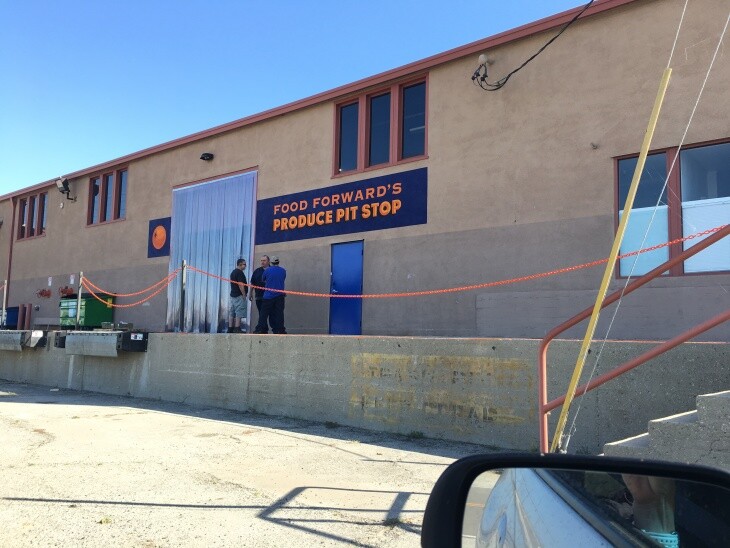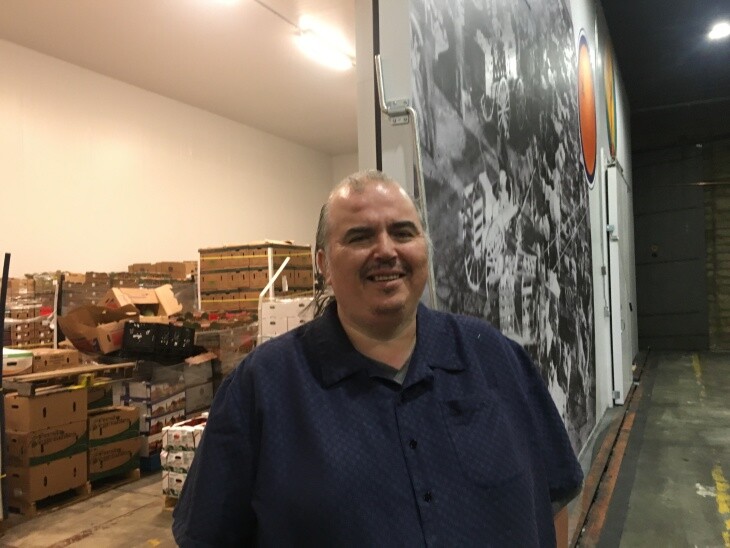With our free press under threat and federal funding for public media gone, your support matters more than ever. Help keep the LAist newsroom strong, become a monthly member or increase your support today.
How One LA Charity Is Keeping Food From Being Wasted -- And Feeding Needy Families

Who among us hasn't tossed out cucumbers past their prime, or an apple with a small bruise?
Now imagine the typical food waste in your home on the scale of one of the biggest produce markets in the nation. And imagine how many people you could feed if that food got to hungry families before it went bad.
At the Los Angeles Wholesale Produce Marketfresh food comes in from around the world on its way to markets around the U.S. And tons of perfectly good produce gets trashed every day -- even as local families go hungry and lack access to fresh fruit and vegetables.
Keeping more of that food out of landfills has been a longtime goal for food banks trying to feed needy families. Logistics and the short shelf life for fresh food can make that tricky.
One local non-profit is now able to rescue more fruits and vegetables from the garbage heap with a solution as simple as four trucks, drivers and a massive walk-in cooler at a warehouse in Bell.

Why Does So Much Good Quality Food Go To Waste?
The big picture is not great. Somewhere between 30% to 40% of food in the U.S. goes uneaten, according to national estimates. That translates to about 133 billion pounds of wasted food each year.
You get a window into why this happens at L.A.'s produce market, where the quantities of food arriving each day are daunting. It's the nation's largest wholesale produce market, by volume. These long, low warehouse buildings house hundreds of vendors, each with their own temperature-controlled storage stacked high with every imaginable type of fresh food.
That's because the downtown location, where the market has been for more than a century, has easy access to farms and orchards of California's Central Valley and Mexico. It's freeway-close to the ports of L.A, Long Beach and Port Hueneme bringing in produce from South America, Australia and Asia.
Farmers and food shippers place their produce with sellers and brokers at the produce market. It's a massive, place and super-busy in the pre-dawn hours.

Electric pallet jacks whiz by on the loading docks as their highly skilled drivers move tons of food from temperature-controlled warehouses onto trucks headed for restaurants and retailers. (Hear an audio version of this story here.)
The massive quantities of food mean some won't sell. Why? Sometimes, too many vendors have too much of the same item and they know they won't be able to sell them because demand is satisfied and prices are falling.
In other cases, food has imperfections or odd shapes and buyers know picky retail shoppers won't select the piece. Produce too close to the end of its shelf life also won't sell, but it's still fine to eat in a day or two.
That's where Food Forward comes in.

From Backyard Fruit Gleaner To Major Food Rescuer
Food Forward started in 2009 with volunteers harvesting unwanted fruits and vegetables from backyards around L.A. County and providing it to local food relief agencies and other charities. Later, it expanded to collecting unsold produce from farmers markets. That move ramped up the quantities and logistical challenges of matching surplus produce with needy families.
Four years ago, Food Forward got a call out of the blue, from a downtown produce vendor asking founder Rick Nahmias if they could take two containers of pineapples. He said yes, but then found out the vendor meant two shipping containers. That's a massive amount of pineapples, but it made clear that produce merchants needed an alternative for disposing of quality food other than sending it to landfills.

The Food Forward pilot project for wholesale food recovery started with one part-time employee, Luis Yepiz, and a borrowed truck.
For years, Yepiz acted as a freelance volunteer at the market, asking for food donations for local charities. That enabled him to build relationships with merchants that paid off when he started collecting food on behalf of Food Forward.
He smashed his goal of collecting 315,000 pounds in the first year, picking up 4.2 million pounds by the end of the year. That haul is now up to nearly 23 million pounds of food a year with four trucks and a full-time crew of produce experts.
Now Yepiz works full-time as the nonprofit's Wholesale Recovery Program Manager.
A Race Against The Clock
Scaling up the nonprofit presented logistical challenges -- the food only stays fresh for about a day or so without a shady cool place to keep it.
Food Forward needed a cool warehouse and walk-in cooler to extend the life of the produce, and last month, they got it.

With a new half-million dollar state grant, Food Forward rented and renovated part of a warehouse in Bell. They call it the Produce Pit Stop and it's already extending the shelf life of produce destined for needy families. The new facility will make it possible for the nonprofit to increase donations by 50% over the nesxt couple of years.
"The most important part of having this warehouse is the refrigerator," Yepiz said.
It was stacked high with pallets of grayish-green Mexican squash the size and shape of baseballs, bags of baby spinach, Roma tomatoes, cherry tomatoes, poblano and jalapeño peppers, broccoli, cauliflower, key limes, and many are the same brands you'd see in a major supermarket.
Having a warehouse and cooler means they can hold produce longer, and create loads for charities that include a greater variety of fruits and vegetables.
What Makes It To The Cooler?
Food Forward doesn't want (or have extra money lying around) to pay expensive landfill or organic composting charges. So it needs to make sure to pick up only the food that can be delivered in good condition to its partner charities and the families they serve.
On a recent market visit, a vendor offers Yepiz six pallets of cucumbers. Yepiz grabs one from a box and snaps it in half. It's got a good sound, but he frowns a bit.
"See how it has freezer damage right here?" he said. "So as soon as this cucumbers get hot they basically turn into mush. So that's why you need to be really careful."
Yepiz agrees to take just two pallets -- about 4,500 pounds of cucumbers -- because he knows he can find takers for that amount but the rest might go to waste. Food Forward accepts donations as long as 85% or more of the food appears usable.

Why Do Merchants Donate Good Food?
Merchants like Marc Kawaguchi like the tax write-off they get for a portion of the value, but just as importantly, "It saves us on our dump charges," he said.
Food Forward founder Nahmias says the new commercial trash hauling system adopted by Los Angeles, called RecycLA, has made it more expensive for produce to be hauled to the landfill. Composting operations are also supposed to grow under the RecycLA program, partly because state law is changing to require organic waste to be composted.

For now, the trash haulers' composting capacity remains very limited, Nahmias said.
The best solution is for more usable food to be channeled to food relief agencies in Los Angeles and surrounding counties. Having a warehouse and giant refrigerator will help make a wider distribution network possible, he said.








